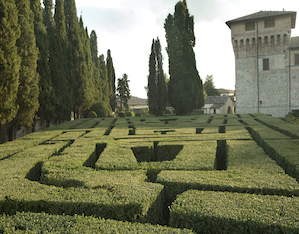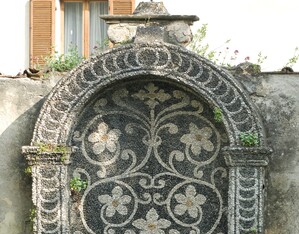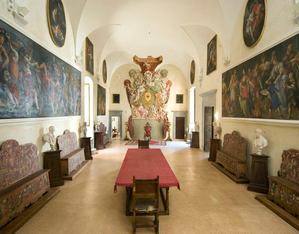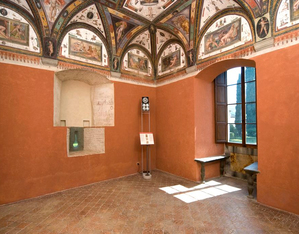From the kingdom of Mars to a realm of Flora: in the 16th century, this former military garrison, complete with towers and a moat, was transformed into a mansion surrounded by gardens. Although modified in later centuries, it still retains a stunning maze and a “ragnaia” for bird-catching from the original layout.
Between 1487 and 1492, Niccolò Bufalini commissioned Roman architect Mariano Savelli to replace a ruined fortress with a new, squared-off fortress featuring four angular towers and a large moat. Between 1530 and 1560, Giulio Bufalini, a colonel in the papal army, and his brother, Abbot Ventura, commissioned Florentine architect Nanni Unghero (of the Sangallo circle) to convert the fortress into an aristocratic residence. The new residence featured a large loggia, porticoes and, around an internal courtyard, a number of halls that retain much of their 16th-to-19th century furnishings. Between 1537 and 1554, Mannerist painter Cristoforo Gherardi decorated the interior with frescoes of mythological subjects. The “Italian-style” garden dates back to this same period. In the 1690s and early 1700s, architect-painter Giovanni Ventura Borghesi turned the building into a fine country residence, by that time at the centre of a large farm estate. In the 18th century, the building was enriched with valuable works of art, including pictorial and decorative cycles in frescoes and on canvas, in part celebrating the Bufalini family, which by this time had been elevated to the rank of Marquis. The garden is arranged on terraces beyond the moat, inside the 18th-century pentagonal wall. Following changes carried out in the first half of the 18th century to the original 16th-century layout, only the beautiful maze and “ragnaia” intended for bird catching have survived. Recently restored, the park consists of seven small gardens, each of a different shape and size. In 1706, Cabreo described the garden’s spaces, tree species, water system, and even the raising of pets and wild animals in detail. To the left of the entrance, he reported that the small flower garden filled with citrus plants was particularly well-cared-for. In the 19th century, a new lemon house was erected against the entrance wall to replace the 18th-century lemon house opposite. In the 20th century, magnolias were planted to further enrich the castle’s plant collection. The State acquired the property in 1989.






